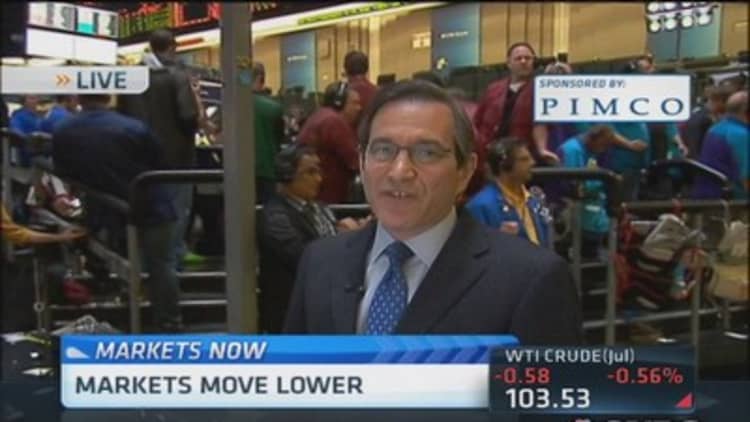
The 10-year Treasury yield fell to a new 2014 low and the lowest level in 10 months, in step with a downshift in global interest rates.
The 10-year is a key rate affecting mortgages and other loans. Traders say one reason for the buying —which pushes rates lower—is that some investors were poorly positioned this year, betting rates would rise. But rates have been falling instead, defying most forecasts and forcing shorts to cover.
"I don't think people who are buying here really want to. They're buying because they're being forced in," said Brian Edmonds, head of interest rate trading at Cantor Fitzgerald. "Look around the world. Everywhere yields are being pushed lower."
The 10-year Treasury yield fell to a low of 2.44 percent, the lowest yield since July on a closing basis. The 30-year has been trading at 11-month lows and touched 3.29 percent Wednesday morning.
The German 10-year Bund yield fell to a low of 1.34 percent, and the the U.S. 10-year moved in lockstep. There was buying along the entire Treasury curve, with the 5-year at a March low of 1.48 percent, ahead of the 1 p.m. $35 billion auction. The auction was mixed, with a yield of 1.513 percent and bid to cover ratio of 2.73.
The Bund yield moved lower Wednesday after German unemployment unexpectedly increased, feeding fears of a global slowdown. Traders also point to the Chinese yuan, at a near 18-month low on concerns about a weak economy and slowdown, led by the property market.
Read MoreCould bond yields be bottoming?
The actions of global central banks has been a major driver, as traders focus on the upcoming European Central Bank meeting next week. The ECB is widely expected to cut rates, but it is not expected to embark on a quantitative easing bond-buying program. However, QE may be discussed by the ECB and markets are looking for guidance on the potential for such a program.
"It's the incredible shrinking yield," said Tom Simons, money market economist at Jefferies. "I think it's a continuation of what we've seen for the last several months. You have structural changes in the market. The data doesn't seem to matter...You've had a lower view of what the Fed's trajectory for the Fed funds rate is going to be for the next couple of years. You still have the Fed sitting there with a balance sheet of over $4 trillion, putting downward pressure on rates."
Simons said he doesn't see a bottom in sight for now, and the market is being driven by the Fed's quantitative easing bond buying program. "It sounds like an easy answer but the longer the QE goes on, the longer the cumulative impact of their purchases is going to be on the market." he said.
As European sovereign rates trade lower, U.S. Treasurys have also become more attractive, on a relative basis.
The move in rates also comes in a vacuum of news Wednesday, but there will be a second look at first quarter GDP Thursday, a number that is likely to be negative.
There has also been some talk of whether rates are close to bottoming, and some of the buying could be attributed to month-end maneuvering.
"It's tough to pick a bottom," said Edmunds. "The next stop is 2 and 3/8 ... I'd be surprised if you rally any more than that but anything can happen in this market."
Traders also say after the ECB meeting the next big hurdle for markets is the May employment report, expected June 7. If strong, that report could be a catalyst for higher yields.
Bank of America Merrill Lynch global technical strategist MacNeil Curry said in a note that rates could continue to push lower and that the bond market remains in a medium-term bull trend. But he also said the move higher in stocks could pose a threat to the long end.
"Such a move could be problematic for Treasury bulls, especially in the long end," Curry wrote. "…Key pivotal support is drawing near," they added, noting for the 30-year the year-to-date trendline is 3.454 percent and the Feb. 4 low of 2.568 percent in 10s are the levels to watch.
—By CNBC's Patti Domm


